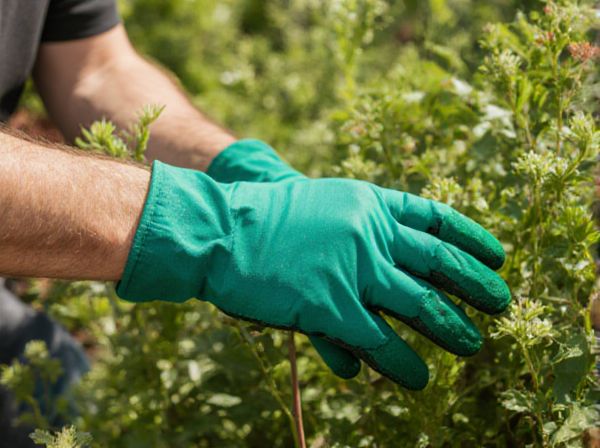
Herbicide vs Hand-pulling Illustration
Herbicides provide a fast and efficient method for controlling large areas of weeds by targeting unwanted plants chemically, reducing regrowth and labor costs. Hand-pulling offers an eco-friendly alternative that minimizes chemical use and prevents soil contamination, but it can be labor-intensive and less effective for extensive infestations. Choosing between herbicide use and hand-pulling depends on the scale of weed problems, environmental impact concerns, and resource availability.
Table of Comparison
| Aspect | Herbicide | Hand-Pulling |
|---|---|---|
| Effectiveness | Fast, targets specific weeds | Labor-intensive, effective for small areas |
| Cost | Moderate to high, chemical expense | Low, mainly labor cost |
| Environmental Impact | Potential soil and water contamination | Eco-friendly, no chemicals used |
| Application | Requires protective equipment and timing | Manual, requires physical effort |
| Weed Types Controlled | Broad-spectrum or selective herbicides | Works best on young or shallow-rooted weeds |
| Time Required | Short, rapid action | Long, especially in large areas |
Understanding Herbicides: Types and Uses
Herbicides are chemical agents classified into selective and non-selective types, targeting specific weed species without harming desired plants or eliminating all vegetation, respectively. Selective herbicides are commonly used in lawns and crop fields to control broadleaf weeds, while non-selective herbicides are applied in areas requiring total vegetation removal, such as driveways and industrial sites. Understanding the mode of action, such as systemic or contact, helps determine appropriate application methods and timing for effective weed control.
Benefits of Using Herbicides in Weed Control
Herbicides offer targeted and efficient weed control by selectively eliminating unwanted plants without harming crops, significantly reducing labor costs compared to hand-pulling. Their ability to cover large areas quickly enhances productivity and prevents weed seed spread, promoting long-term weed management. Modern herbicides also reduce soil disturbance, preserving soil structure and preventing erosion better than mechanical removal methods.
The Pros and Cons of Hand-Pulling Weeds
Hand-pulling weeds offers precise removal with minimal soil disturbance, making it ideal for small gardens and areas with delicate plants. However, this method is labor-intensive and less effective for extensive weed infestations or deep-rooted species like bindweed and morning glory. While hand-pulling avoids chemical use, reducing environmental impact, it may require repeated efforts to manage persistent weeds effectively.
Environmental Impact: Herbicide vs Hand-Pulling
Herbicide application often introduces synthetic chemicals into the soil and water systems, potentially harming non-target plants, insects, and aquatic life, while hand-pulling weeds avoids chemical contamination and preserves biodiversity. Although hand-pulling is labor-intensive, it promotes soil health by preventing chemical residue buildup and minimizing disruption to beneficial organisms. Balancing effectiveness and environmental impact, hand-pulling is generally favored in sensitive ecosystems to maintain ecological integrity and reduce pollution risks.
Cost Comparison: Chemical Solutions vs Manual Labor
Herbicide treatments typically cost between $25 and $50 per acre, offering a scalable solution for large infestations, while hand-pulling expenses can rise to $100 or more per acre due to labor intensity. Chemical herbicides often require fewer applications, lowering long-term costs compared to repetitive manual removal, which demands significant time and physical effort. Despite higher upfront chemical costs, herbicides generally provide a more cost-effective and efficient weed management approach over extensive areas.
Effectiveness in Different Garden Sizes
Herbicide application offers quicker control and is more effective for managing extensive weed infestations in large gardens, minimizing labor and time. In contrast, hand-pulling provides precise weed removal ideal for small garden areas, reducing chemical exposure and preserving surrounding plants. Choosing between herbicides and hand-pulling depends on garden size, weed density, and desired environmental impact.
Safety Precautions for Herbicide Application
Herbicide application requires strict adherence to safety precautions, including wearing protective gloves, goggles, and long-sleeved clothing to prevent skin and eye contact with toxic chemicals. Proper ventilation and avoiding herbicide use on windy days reduce inhalation risks and off-target drift. In contrast, hand-pulling eliminates chemical exposure but demands physical caution to avoid repetitive strain injuries and contact with potentially harmful plants.
Long-Term Results: Chemical vs Manual Weed Removal
Herbicide applications provide effective long-term weed control by targeting deep root systems and preventing regrowth, which reduces the frequency of treatments needed over time. Hand-pulling, while environmentally friendly and chemical-free, often requires repeated efforts due to incomplete removal of roots and potential seed dispersal. Studies indicate that integrating selective herbicide use with manual removal methods yields the most sustainable weed management by minimizing herbicide reliance and ensuring long-term suppression of invasive species.
Weed Identification: When to Pull vs Spray
Effective weed management hinges on accurate weed identification to decide when to pull by hand or apply herbicides. Broadleaf weeds like dandelions are often better controlled through hand-pulling before seed set, while grassy weeds such as crabgrass typically require targeted herbicide treatment for effective eradication. Early identification during the seedling stage enhances the precision of control methods, reducing chemical use and promoting sustainable weed management.
Choosing the Right Method for Your Garden
Selecting the right weed control method depends on your garden's size, plant types, and environmental considerations. Herbicides offer efficient control for large infestations but require careful application to avoid harming desirable plants and the ecosystem. Hand-pulling is labor-intensive but provides precise removal, ideal for small gardens and maintaining organic practices without chemical exposure.
Herbicide vs Hand-pulling Infographic

 gardendif.com
gardendif.com